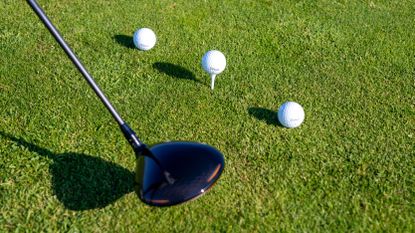How To Stop Cutting Across The Golf Ball
Golf Monthly Top 50 Coach Alex Elliott offers a great drill for how to stop cutting across the golf ball through impact


Cutting across the golf ball is a common amateur fault, and could be one of the main reasons you aren't getting better at golf. Fixing this problem isn't difficult, providing you receive the best golf tips, so we sought the expertise of Golf Monthly Top 50 Coach Alex Elliott to help you develop a better swing pattern and stop you slicing the ball for good...
How To Stop Cutting Across The Golf Ball
There is a great quick win here that all amateurs can try. Locate, or draw, the line on your ball and point it towards the target. Create a gate to swing the clubhead through, using tee pegs or a couple of spare balls (demonstrated in the image below), as this will help to exaggerate the opposite move to the type you have been battling.
This will help to create an in-to-out path, and through repetition of this great drill you can develop those feels to take with you onto the course. Once you have setup this drill, raise the head of your driver off the ground and make some practice swings to get a sense of what you are trying to achieve. Give this a go at a sensible speed and ramp it up once you notice some success.

This simple gate drill will help you stop cutting across the ball
This exaggerated way of practising helps you learn the difference between feel and real and should work you into a nice middle ground. Another reason it’s effective is because with the tees or balls in place, you should get some instant feedback as to whether you are swinging the club through the gate you’ve created.
It goes without saying, but we’d recommend using tees to start with to ensure no damage is done in the event of any mishaps.
Over time, the benefits of honing this move will be noticeable. For one, it will improve the quality of strike and allow you to get more power in your golf swing, which will also lead to increased ball speed and distance.
Get the Golf Monthly Newsletter
Subscribe to the Golf Monthly newsletter to stay up to date with all the latest tour news, equipment news, reviews, head-to-heads and buyer’s guides from our team of experienced experts.

Location: Mottram Hall
Alex spent a great deal of time learning the game from fellow northwest golfer, Andrew Murray, who was a European Tour regular from 1979 to 1995. He spent three years on the European Tour caddying for Andrew’s son, Tom, before taking his PGA qualifications. His passion for the game and personality in front of the camera has helped him to create a thriving social media platform on Instagram and YouTube, where he offers a whole host of tips and advice to help viewers shoot lower scores.
Most significant influences on your teaching:
Mike Bender's book, 'Build The Swing Of A Lifetime', which I read during my PGA qualifications. He uses so many different tools to help students deliver the club better when hitting the golf ball. Andrew Murray, too. He helped form the way I interact with golfers and simplified what can be a complex game for a club golfer.
Advice for practice:
I like to get students to work in sets of five golf balls – three drills shots to two course shots. The drill shots have no consequence, but with the two course shots, I ask the student to create a green or fairway and go through a full routine.
Greatest success story:
One of my students hadn’t played golf for ten years - he'd lost his love for the game. After watching my online Instagram and YouTube content, he came for several golf lessons and has now joined a local golf club. Knowing I've helped get someone back into golf... you can't beat that.
-
 Masters Runner-Up Ludvig Aberg Has Major Ambitions (And World No.1 Goal)
Masters Runner-Up Ludvig Aberg Has Major Ambitions (And World No.1 Goal)The Swede sensation is targeting Major glory after pushing World No.1 Scottie Scheffler all the way at Augusta
By Michael Weston Published
-
 TecTecTec Team8E Golf GPS Earbuds Review
TecTecTec Team8E Golf GPS Earbuds ReviewJoe Ferguson gets his first experience of golf-specific GPS wireless headphones…
By Joe Ferguson Published